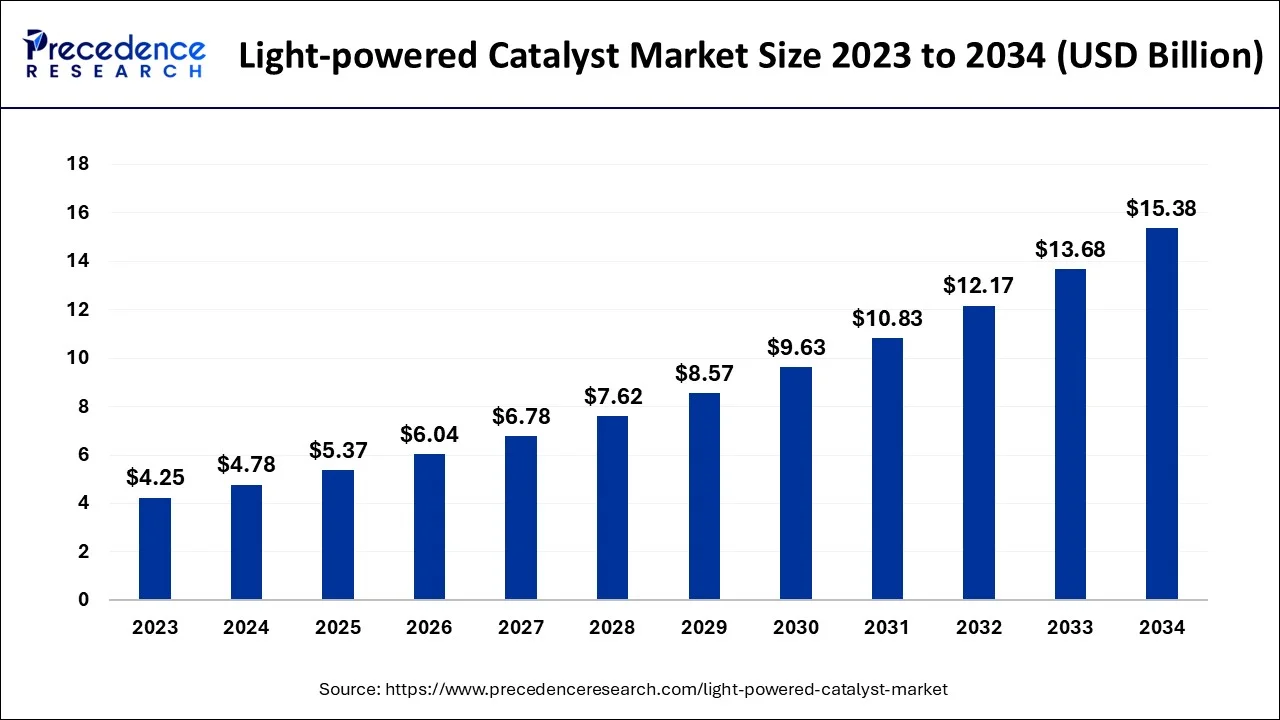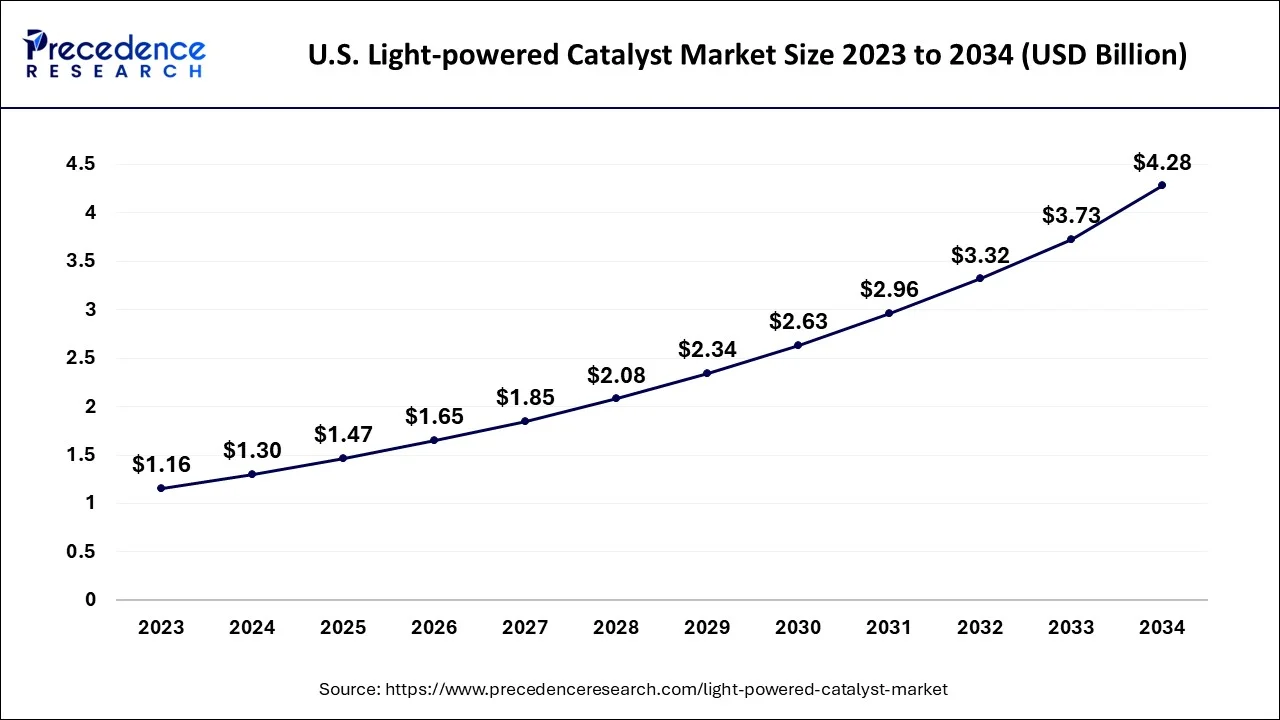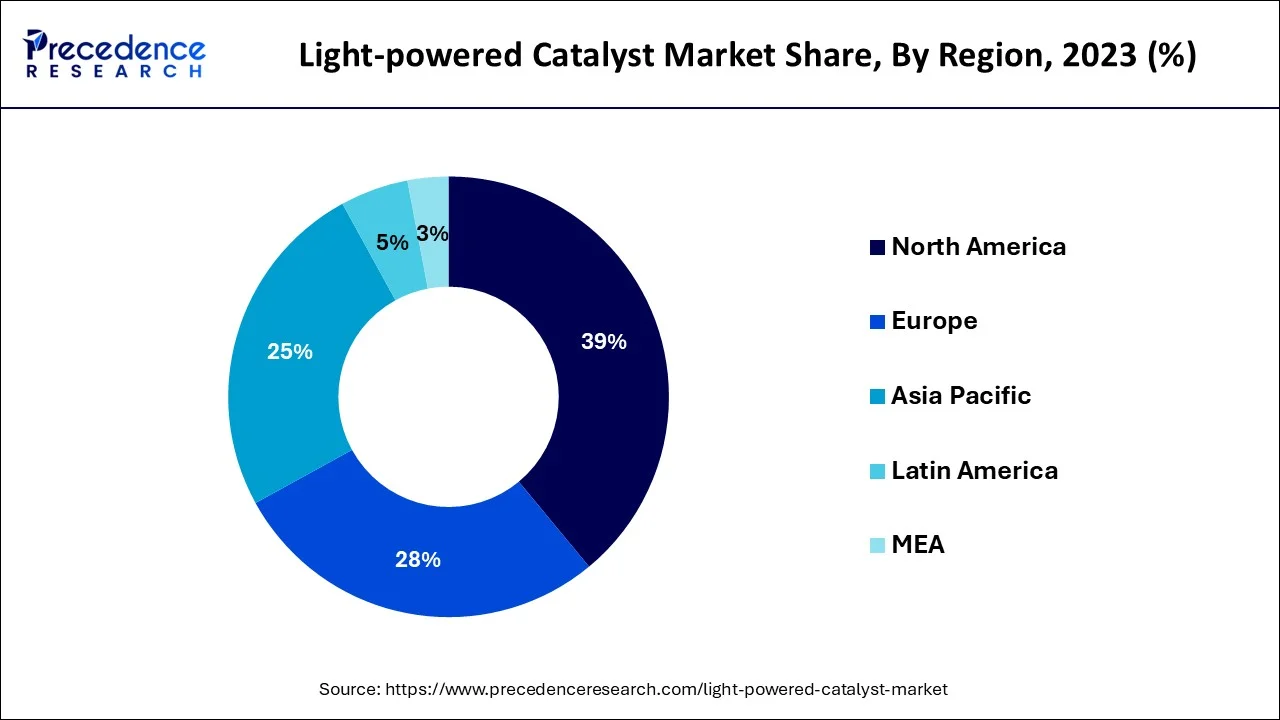What is the Light-powered Catalyst Market Size?
The global light-powered catalyst market size is valued at USD 5.37 billion in 2025 and is predicted to increase from USD 6.04 billion in 2026 to approximately USD 16.95 billion by 2035, expanding at a CAGR of 12.18% from 2026 to 2035.

Light-powered Catalyst Market Key Takeaways
- North America dominated light-powered catalyst market in 2025.
- By raw material, the chemical compounds segment dominated the market in 2025.
- By application, the chemicalSynthesis segment led the market in 2025.
- By product, the heterogeneous catalysts segment led the market in 2025.
Strategic Overview of the Global Light-powered Catalyst Industry
Light-driven chemical reactions provide a strong tool for scientists developing novel methods of producing medicines and other important molecules. Photoredox catalysts, that absorb light and transmitting energy to those chemical processes, are required to harness the light energy. The innovative catalysts, that could be tailored to conduct a wide range of reactions, might potentially be put into other materials such as fabrics or particles. Photoredox catalysts operate by receiving photons and then converting that light energy into chemical energy, similar towards how chlorophyll in plant cells receives solar energy and utilizes it to make sugar molecules.
The catalysts also might be utilised coat magnetic beads, rendering them easier to remove from the solutions once the reaction is complete, as well as to coat reaction vials or fabrics. The researchers are currently focusing on adding a larger range of catalysts into their polymers, as well as designing the polymers to optimise them for various uses.
The increasing need for catalysts across applications such as polymers and petrochemicals, chemical synthesis, petroleum refining and environmental is creating a market among manufacturers worldwide for process optimization, yield improvement, cost-saving and energy-saving. Furthermore, environmental catalysts assist manufacturers in meeting all of the strict NOx, SOx, and co2 emission standards. Catalyst consumption has increased due to shifting energy patterns toward alternative fuels such as biodiesel and shale gas fuel. Furthermore, businesses aiming to add value to their feedstock or refining by generating value-added petrochemicals and chemicals such as methanol and polyolefins have boosted demand from petrochemicals and chemicals applications.
The unusual outbreak of COVID-19, which has resulted in the closure of industries and production facilities, has resulted in a large drop in demand for oil, the first such occurrence in a decade. Furthermore, the price war between Russia and Saudi Arabia has resulted in a significant drop in oil prices. Due to a stop in air travel and national lockdowns, global gasoline demand is predicted to fall by 15-10% in Q2, 2020. A number of facilities have been shut down, and others are operating at reduced rates, which may have an influence on market demand, particularly in Iran, the United States, France, Italy, China, India, and the United Kingdom, which are among the worst-affected economies.
Artificial Intelligence: The Next Growth Catalyst in Light-powered Catalyst
AI is fundamentally reshaping the Light-powered Catalyst market by moving beyond basic robotic process automation (RPA) to enable systems that can reason, understand context, and learn from experience. It allows for the automation of complex, knowledge-based tasks that traditionally required human judgment, such as processing unstructured data from documents, handling customer service inquiries with a nuanced understanding, and making sophisticated business decisions.
The integration of advanced AI models like Large Language Models (LLMs) significantly enhances the capabilities of Light-powered Catalyst platforms, enabling more intuitive interactions and efficient operations in real-time.
Light-powered Catalyst Market Growth Factors
A biohybrid photocatalyst is a novel form of catalyst that incorporates a light-harvesting protein that collects light and transmits the energy to a metal-containing catalyst. This catalyst then converts the energy into reactions that can be used to synthesise medications or transform trash into bio fuels or other valuable molecules. This sort of photocatalyst might also be employed to drive a reaction known as lignin depolymerization, which could aid in the production of bio fuels from hardwood or other challenging plant materials.
Catalysts currently employed in the synthesis of solar fuels have severe limits, driving research into the creation of an efficient, resilient, and sustainable catalyst that is triggered by light, known as a photocatalyst. Imperial College London researchers are one step closer to doing this after a recent study uncovered the capability of organic photocatalysts known as hyper-cross linked polymers (HCP). This means that solar fuels may be generated more sustainably, assisting in the transformation to net zero emissions.
The need for rare-earth elements raises serious concerns about sustainability. Extraction of rare-earth metals, for example, is costly and inefficient, requiring extensive regions to be mined, which can cause severe environmental damage as well as leakage of poisonous and radioactive elements. Furthermore, typical semiconductors are frequently active at ultraviolet wavelengths, which account for around 4% of the sun spectrum, limiting their applicability. This has resulted in the creation of more efficient and robust visible-light-active photocatalysts that need less rare-earth metals.
The scientists also demonstrated that depending on the application, they could alter the physical features of a polymer backbone, such as thickness and porosity. They demonstrated, for example, that they could create fluorinated polymers that would adhere to fluorinated tubing, which is commonly used in continuous flow production. Chemical reagents flow through with a series of tubes when additional components are introduced or other stages such as filtration or isolation are conducted during this sort of production.
In recent years, the development of novel materials such as graphene and graphene oxide (GO) as photocatalysts has increased due to their sustainability and flexibility in photocatalyst modification and design. In addition to these benefits, the inclusion of cationic or anionic dyes can be used to enhance the photocatalytic activity of GO under visible light. Some dyes that are sensitive to visible light are employed in photocatalytic devices. Under visible light irradiation, excited dyes can inject electrons into semiconductor conduction bands, initiating photocatalytic processes.
One of the most important reactions in organic chemistry is selective oxidation. Solar light photocatalytic oxidation of organic molecules is a potential technique for ecologically friendly conversion processes. In recent years, the ability to use low-cost and environmentally acceptable procedures rather than powerful oxidants that create hazardous wastes has become critical. As a result, there is considerable interest in performing these processes in light-powered catalysts.
Market Outlook
- Market Growth Overview: The light-powered catalyst market is expected to grow significantly between 2025 and 2034, driven by environmental remediation, technological innovation, and advanced coating and smart materials.
- Sustainability Trends: Sustainability trends involve integration with renewable energy and green hydrogen production, development of visible-light catalysts, and environmental remediation and green chemistry.
- Major Investors: Major investors in the market include BASF SE, Johnson Matthey, Evonik Industries AG, Umicore Group, and Dow Chemical Company & Clariant AG.
- Startup Economy: The startup economy is focused on renewable energy and green hydrogen production, nanotechnology and advanced material R&D, and environmental remediation and green chemistry solutions.
Market Scope
| Report Coverage | Details |
| Market Size in 2025 | USD 5.37 Billion |
| Market Size in 2026 | USD 6.04 Billion |
| Market Size in 2035 | USD 16.95 Billion |
| Market Growth Rate from 2026 to 2035 | CAGR of 12.18% |
| Largest Market | North America |
| Base Year | 2025 |
| Forecast Period | 2026 to 2035 |
| Segments Covered | Raw Material, Product, Application, and Region |
| Regions Covered | North America, Europe, Asia-Pacific, Latin America and Middle East & Africa |
Light-powered Catalyst Market Segment Insights
In 2025, chemical compounds emerged as the market's dominating raw material category, with a 39% value share. Hydrofluoric, Sulphuric acid, acid, and calcium carbonate are utilised as catalyst raw materials in a wide range of applications in the chemical, petrochemical, and polymer industries. Noble metals (platinum, palladium, ruthenium, rhodium, gold, and copper) and non-noble metals (tungsten and molybdenum) are utilised for dehydrogenation and hydrogenation, while nickel and cobalt are also employed as essential catalyst raw materials. These metals accelerate the process of breaking and reorganizing aromatics and olefins to form alkanes and naphthenes. Aside from metals and inorganic compounds, zeolites are another type of notable raw material utilised in catalysts. Due to their porosity and vast surface area, zeolites are mostly employed in catalyzing and adsorbent applications. Because of their porous structure, zeolites can accept a wide range of ions. These can be acquired naturally or created commercially through crystallization processes.
With a value share of 73% in 2025, heterogeneous catalysts emerged as the market's most important product group. To minimise toxicity, homogeneous catalysts are transformed into heterogeneous catalysts using solid supports. Suffocated carbon materials, Sulphated zirconia, sulfonated silica materials, and sulfonated MOF materials are all examples of heterogeneous catalysts. The advantages of heterogeneous catalyst application include low cost, easy separation of catalyst from products, and convenience of application, all of which are expected to promote the industry. Furthermore, the acceptability of heterogeneous catalysts over homogeneous equivalents for biodiesel production is expected to boost catalyst market growth throughout the forecast period. Homogeneous catalysts include hydrochloric acid, boric acid, phosphoric acid, p-toluenesulfonic acid, and sulphuric acid. These catalysts are said to perform better in industrial and raw material reactions than heterogeneous equivalents. These operations, however, generate massive volumes of hazardous waste, posing environmental risks. This has driven the need for environmentally friendly catalysts, and the development of biodegradable homogeneous catalysts such as methanesulfonic acid (MSA) has aided in meeting such needs.
Chemical synthesis ranked as the market's most important application category in 2022, with a value share of 26.5% for heterogeneous catalysts. Chemical synthesis comprises raw material and raw material chemistry, where catalysts are used in processes such as Haber, Contact, and turning ammonia to nitric acid. As a result, expansion in the worldwide chemical sector is predicted to boost catalyst demand throughout the forecast timeframe. Catalysts are widely used in chemical synthesis because of their superior traits and qualities, such as the stimulation of alkene and alkyne activation, enantioselective processes, and increased stability. They also have excellent functional group tolerance, are cost-effective, and do not require extra ligands. All of the aforementioned factors are driving the segment's growth by boosting the usage of catalysts in chemical synthesis. Catalysts are typically utilized in the cracking feedstock components of petroleum refining to boost the production of high-quality products, in addition to chemical synthesis. The use of a catalyst increases the optimization of hydrocracking processes while also conserving money and energy. This has aided market expansion in petroleum refinery applications.Raw Material Insights
Product Insights
Application Insights
Light-powered Catalyst Market Regional Insights
The U.S. light-powered catalyst market size accounted for USD 1.47 billion in 2025 and is predicted to be worth around USD 4.74 billion by 2035, growing at a CAGR of 12.42% from 2026 and 2035. North America dominated the market with the largest share in 2025. This is due to the region's strict regulations to reduce the amount of sulfur in diesel fuel, which necessitates the use of catalysts. The increased production of crude oil in the U.S. has increased the adoption of catalysts to convert heavy crude oil into light fractions. Furthermore, the rapid expansion of oil & gas and chemical industries in countries like the U.S., Canada, and Mexico contribute to regional dominance. Asia Pacific is expected to experience rapid growth in the market in the near future, owing to the rapid expansion of the chemical & petrochemical and oil & gas industries. China is a major contributor to the market due to its dominance in the automotive, polymer, and chemical sectors. Moreover, rising industrialization in countries like India and China contributes to market growth in Asia Pacific.
The U.S.'s light-powered catalyst market is experiencing significant growth, driven by stringent environmental regulations and a focus on sustainable solutions for air and water purification. While titanium dioxide remains dominant, innovation is pushing for more efficient catalysts that operate under visible light. The market is also characterized by the integration of advanced manufacturing techniques and a significant application in renewable energy, particularly for hydrogen production.
China's light-powered catalyst market is dominated by stringent government environmental regulations and a strong push for domestic production and self-sufficiency. Key trends include major R&D in nanotechnology for developing more efficient visible-light catalysts and significant applications in the renewable energy sector, particularly for hydrogen production.
Germany's Light-powered Catalyst market is stringent EU environmental regulations and the nation's leadership in Industry 4.0, emphasizing sustainability in industrial applications. Key factors also include strong R&D in nanotechnology for developing efficient visible-light catalysts and significant applications in the renewable energy sector, particularly for green hydrogen production.

Value Chain Analysis of the Light-powered Catalyst Market
- Raw Material Extraction & Processing:
This foundational stage involves sourcing and processing base materials such as titanium dioxide (TiOâ‚‚) precursors, various metal oxides, and advanced nanomaterials that form the core of the catalysts.
Key Players: DuPont de Nemours, Inc., Tayca Corporation, Tronox Holdings plc, Evonik Industries AG, Huntsman Corporation. - Catalyst Material Design & R&D:
This stage focuses on innovation, where material scientists use advanced modeling, nanotechnology, and AI-driven generative design to engineer new catalyst materials optimized for specific light spectra (especially visible light) and target applications (e.g., water splitting, air purification).
Key Players: Dalian Institute of Chemical Physics (CAS) (China R&D), Fraunhofer Institute (Germany R&D), Massachusetts Institute of Technology (MIT) (U.S. R&D), University research labs, Specialized material science startups. - Manufacturing & Reactor Fabrication:
This stage converts processed materials into final catalyst forms (powders, coatings, composites) and builds the associated reactor systems where the light-powered reactions occur.
Key Players: Kofax Inc. (manufacturing tech), SGL Carbon (composite materials), Various specialized coating application companies, Industrial equipment manufacturers. - Integration & Application Deployment:
This stage involves integrating the catalyst materials and reactor systems into final commercial applications, such as large-scale municipal water treatment plants, industrial air purification systems, self-cleaning building coatings, or hydrogen production facilities.
Key Players: SUEZ SA (water treatment solutions), Veolia Environnement S.A. (environmental services), Honeywell International Inc. (air purification/industrial automation), Various construction chemical companies. - Monitoring, Support, and End-of-Life Management:
This final stage involves the ongoing monitoring of catalyst performance, system maintenance, and eventual replacement/recycling of catalyst materials to ensure sustained efficiency and compliance with environmental regulations.
Key Players: SUEZ SA (environmental services/monitoring), Veolia Environnement S.A. (environmental services/monitoring), Industrial monitoring technology companies, Specialized recycling companies.
Top Companies in the Light-powered Catalyst Market & Their Offerings
- Albemarle Corporation: Albemarle focuses primarily on the production of specialty chemicals and catalysts for the refining and petrochemical industries through its Ketjen subsidiary.
- Johnson Matthey: Johnson Matthey is a world leader in the development and manufacture of catalysts for automotive emissions control, energy systems (like hydrogen production), and fine chemicals synthesis.
- BASF SE: BASF is a global leader in catalysts, providing a wide range of solutions for environmental protection, fuel production, and chemical processes. They produce specific indoor air quality catalysts like Formaldpure� for formaldehyde removal, which operate via chemical reactions, but they are generally listed as a major competitor in the broad catalyst market that includes light-powered solutions.
- Chevron Phillips Chemical Company LLC: This company is a producer of olefins and polyolefins and a key supplier of catalysts used in the petrochemical industry, particularly for selective acetylene hydrogenation in ethylene plants.
- Clariant AG: Clariant is a prominent global supplier of specialty catalysts and adsorbents used across various chemical and industrial applications, with a strong emphasis on sustainability and reduced emissions.
- Dorf Ketal Chemicals (I) Pvt. Ltd.: Dorf Ketal specializes in a wide range of chemical solutions, including process chemicals and catalysts for the refining, petrochemical, and water treatment industries.
- Dow Chemical Company: Dow provides a diverse portfolio of advanced materials and specialty chemicals, including catalysts used in various industrial and chemical manufacturing processes.
- Evonik Industries AG: Evonik is a world leader in the catalysts industry, offering full-cycle catalyst solutions across various applications with a strong commitment to sustainability.
- Exxonmobil Corporation: ExxonMobil is a major player in the energy and petrochemical sectors and develops catalysts primarily for internal use in refining processes to produce fuels and specialty chemicals efficiently.
- W.R. Grace and Co: Grace is a leading global supplier of catalysts for the petroleum refining (especially fluid catalytic cracking) and chemical industries.
Light-powered Catalyst Market Companies
- Albemarle Corporation Johnson Matthey
- BASF SE
- Chevron Phillips Chemical Company LLC
- Clariant AG
- Dorf Ketal Chemicals (I) Pvt. Ltd.
- Dow Chemical Company
- Evonik Industries AG
- Exxonmobil Corporation
- Johnson Matthey
- W.R. Grace and Co
Light-powered Catalyst Market Segments Covered in the Report
By Raw Material
- Chemical compounds
- Metals
- Zeolites
- Others
By Product
- Heterogeneous Catalyst
- Chemical synthesis
- Chemical catalysts
- Adsorbents
- Syngas production
- Others
- Petroleum refining
- FCC
- Alkylation
- Hydrotreating
- Catalytic Reforming
- Purification
- Bed grading
- Others
- Polymers and petrochemicals
- Ziegler Natta
- Reaction Initiator
- Chromium
- Urethane
- Solid Phosphorous Acid catalyst
- Others
- Environmental
- Light-duty vehicles
- Motorcycles
- Heavy-duty vehicles
- Others
By Geography
- North America
- U.S.
- Canada
- Europe
- U.K.
- Germany
- France
- Asia-Pacific
- China
- India
- Japan
- South Korea
- Malaysia
- Philippines
- Latin America
- Brazil
- Rest of Latin America
- Middle East & Africa (MEA)
For inquiries regarding discounts, bulk purchases, or customization requests, please contact us at sales@precedenceresearch.com
Frequently Asked Questions
Ask For Sample
No cookie-cutter, only authentic analysis – take the 1st step to become a Precedence Research client
 sales@precedenceresearch.com
sales@precedenceresearch.com
 +1 804-441-9344
+1 804-441-9344